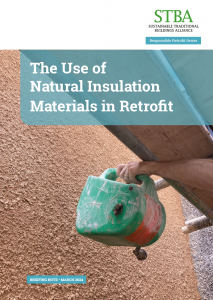In a new paper, the STBA, which is hosted by the SDF, has identified a number of barriers to best practice retrofit of traditional solid wall buildings, and calls for steps to be taken to remove these barriers, facilitate sustainable retrofit, and ensure the use and enjoyment of our heritage buildings for years to come. 25% of the UK’s building stock is of traditional construction, meaning they are solid-walled and rely on a vapour-open strategy to manage moisture. For these buildings, the unconsidered use of modern impermeable materials can introduce a risk of moisture accumulation and resultant damp and mould.
The paper, ‘The Use of Natural Insulation Materials in Retrofit’, explores the energy and carbon characteristics of natural materials, their moisture handling characteristics, and the regulatory context.
On the basis of its analysis, it calls for five actions from government that will help enable best practice retrofit of traditional buildings. The recommendations are to:
- Eliminate the requirement for a 25-year guarantee on solid wall insulation from current Trustmark lodgment rules. Consider introducing a requirement for a 10-year guarantee, or use public funds to expedite longer-term guarantees for natural materials.
- Work with the insurance industry to help them understand the ways in which natural materials can help de-risk retrofit.
- Ensure that the Government’s own guidance on internal wall insulation across all typologies is well understood by all relevant policy officers.
- Establish a broad range of metrics for retrofit materials, to encompass: resource scarcity, sequestered carbon, embodied energy, water use and embodied pollution. EPDs (Environmental Performance Declarations) or Materials Passports could be considered as a starting point.
- Establish a broad range of metrics for retrofit, including benefits to health, welfare, net energy savings, water efficiency and sustainable drainage, and include wider community benefits such as employment, green spaces, and social cohesion.
